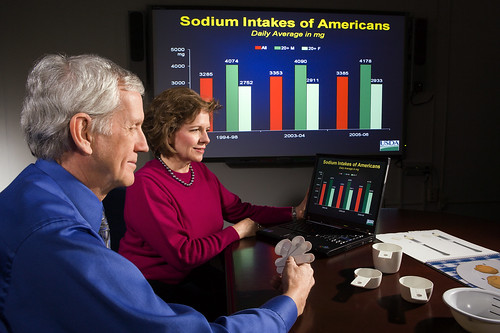
March is National Nutrition Month. Throughout the month, USDA will be highlighting results of our efforts to improve access to safe, healthy food for all Americans and supporting the health of our next generation.
The U.S. food supply is abundant, but many consumers are experiencing nutritional shortfalls. Some are overfed but undernourished at the same time. Observing trends in U.S. diets is possible based on food-consumption data collected during the annual “What We Eat in America/NHANES” dietary-intake survey.
The USDA Agricultural Research Service (ARS) is responsible for the consumption interview, one of several components of the National Health and Nutrition Examination Survey (NHANES) conducted by the U.S. Department of Health and Human Services. The dietary survey is managed by researchers at the Food Surveys Research Group in Beltsville, Md., part of the ARS Beltsville Human Nutrition Research Center.
Each year, the “What We Eat in America” computer-based dietary interview is used to ask more than 5,000 individuals nationwide about the foods and beverages they consumed. The participants’ dietary supplement intakes also are collected.
Research nutritionists then translate “what’s eaten” into “nutrients consumed.” The survey data—after analysis—provide insights into the population’s nutrient-intake status, such as overconsumption, nutritional shortfalls, healthy snacking and poor eating.
Here are some of the dietetic trends based on “What We Eat in America” survey data collected in 2011-2012.
—On average, U.S. individuals are getting only about half their daily recommended intake for dietary fiber and potassium. And well over one-third aren’t getting their recommended calcium, magnesium, vitamin C and vitamin A from foods and beverages.
—More than 90 percent are not getting their recommended vitamin D from foods and beverages. Based on supplement use tracked, about one-fourth took a supplement containing vitamin D, and more than half of women aged 60 and older took one.
—Lunch is the meal most frequently skipped. On any survey day, one in five individuals did not eat lunch.
—On a given day, more than half of individuals ate at least one food or beverage that was obtained from a restaurant. The proportion is higher for young adults. Two-thirds of those aged 20 to 39 ate food or beverage obtained from a restaurant. When consumed, restaurant foods and beverages contributed more than 40 percent of daily calories.
—Overconsumption also is a problem. Based on the survey data, individuals consumed 3,500 milligrams of sodium on a given day, which is about one-third more than the recommended maximum for adults with no known risk factors.
Essential vitamins and minerals help the body stay healthy and function properly. “What We Eat in America” data results are informative to consumers and professionals. To keep up with what’s trending based on “What We Eat in America,” visit the USDA-ARS Food Survey Research Group Web site.




